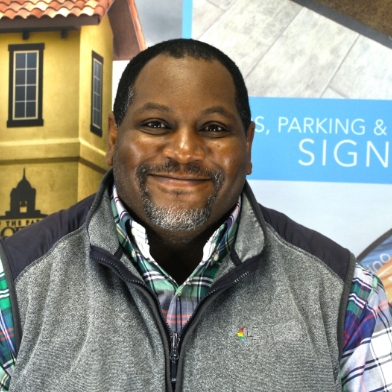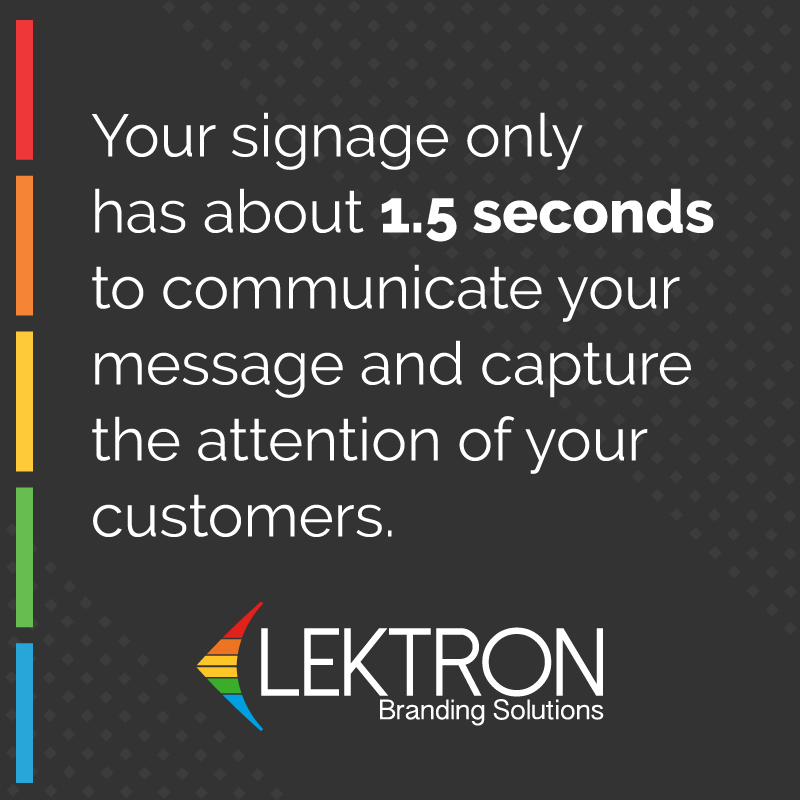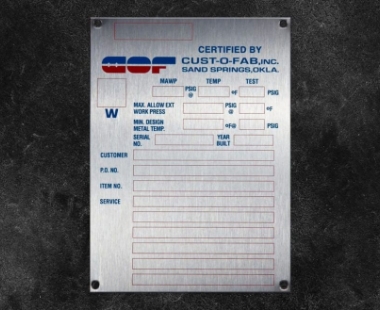

By Roland Williams
Business Development Executive
For most small businesses throughout North America, signage comprises the majority of their marketing budget, and for good reason: Over one-third of consumers state that signage — and the legibility, visibility, and design that signage — plays a significant role in how they view a brand’s overall quality and ability to provide satisfactory service.
And it’s no wonder why signage has such a direct impact; it wears a lot of hats: It announces to passersby where your business is located; it communicates your brand’s branding, style, and emotional tone; and it often communicates special offers that further entice potential customers to visit.
This versatility, communication, and attention-grabbing power make quality signage one of the most worthwhile investments your business can make.
All too often, though, brands make key design and implementation mistakes that severely degrade their signage’s ability to capture attention, communicate a message, and ultimately make money for the business.
But by understanding these crucial elements of signage visibility and legibility, how unreadable signage impacts your brand’s bottom line, and how you can prevent these missteps, you can ensure you’re getting the most out of your signage investment
The Factors that Degrade Signage Legibility
No matter how much of your marketing budget is spent on top-quality custom-made signage, your spend is all for nothing if it goes unnoticed or it’s difficult to read.
To best understand the potential pitfalls you might encounter when planning, designing, or placing your signage, let’s turn to the hard data to get an objective look on how to optimize your signage’s visibility and legibility.
1. Poor signage location, line of sight, or angle
Knowing your audience and the location of that audience you’re looking to reach is one of the first and most important steps toward ensuring your signage is effective.
But even if you’ve picked the perfect neighborhood or city block to feature your signage, your audience may never get the chance to see your message if it’s obscured buildings or overgrown brush, or if it’s positioned at an angle that doesn’t meet the line of sight of the oncoming automotive traffic or foot traffic you’re targeting.
When working with a quality signage provider like Lektron, all of these variables that might affect your signage’s effectiveness are accounted for and incorporated into the messaging, positioning, and design of your sign.
2. Improper signage size
If a sign is too small, it likely won’t attract traffic or help increase public awareness of your offer. But bigger doesn’t always mean better when it comes to how effective your signage is at grabbing attention.
Should your sign’s text or physical size be too large for the space you’re targeting, it might be too much to visually take in with a single glance, causing potential customers to altogether ignore the message you’re trying to communicate.
And how well your sign communicates with a single glance is critical. In our multi-device, faster-than-ever world, your signage only has about 1.5 seconds to communicate and capture the attention of your customers.
Finding the proper sign size boils down to knowing:
- The local laws and ordinances that dictate permitted signage sizes
- Your target audience and their interests
- Your target location
- How your audience is going to interact with that location.
When you’re equipped with that knowledge and you’re working with a signage expert who can help you optimize every aspect of your signage’s design, placement, and performance, you’re well on your way to achieving a much higher ROI from your signage.

3. Signage text that’s too small or too close together
On paper, it might seem like a good idea to try to squeeze more information onto a sign by making the text size smaller. After all, more information is always better, right?
When it comes to high-performing signage, that’s not exactly the case. But let’s look at the data for a more objective few into why more simplicity in messaging and text makes for a more readable and enjoyable sign for your customers.
In 2012, in one of the largest studies of its kind, researchers from the University of Cincinnati’s College of Business reviewed the feedback of more than 100,000 customers that had expressed frustration with signage that was too difficult to read.
The #1 answer — commanding 83% of respondent’s top choice as the most frustrating element — was text size that was too small. And close behind text size? Text that was too close together.
So before committing to a large block of text to inform your customers of your new location, special offer, or updated product, take the time to simplify your message down to its most elemental message. Taking this crucial step will keep your message clear and allow more room for a more readable text size.
4. Insufficient signage luminance and low-light visibility
Throughout the daylight hours, most well-designed signage will be easily readable. But as soon as the sun goes down, your signage’s readability — and your ability to reach customers — can take a hit if you’re not prepared.
To maximize your signage investment with respect to visibility, reflect on when your business is aiming to draw in the most foot traffic and the nature of your business itself.
For instance, if you’re a nightclub, illuminated signage is a must to ensure your customers to get a feel for your club’s unique feel, and for them to simply know where you are and that you’re open.
Do bear in mind, though, that your signage also plays a key role in keeping your business at the top of your customers’ minds, too.
Even if your business is closed during the moment one of your potential customers might pass by, their ability to see your signage clearly reminds them of their need to do business with you or, at the very least, that you’re an available and local option should they need your services in the future.
5. Overly complex or “fancy” fonts
Using a standardized set of fonts throughout your business is a staple of effective and consistent branding. Naturally, if your brand favors more complex font stylings on digital or printed media, it can feel right to use the same fonts in your signage, too.
However, when it comes to making sure your message is visible and communicated clearly, overly-fancy fonts — like those with complex serif stylings, unique kerning, or cursive-like aesthetics — can do more harm than good.
Those extra layers of complexity in your font take extra time for the human brain to parse, as they tend to interrupt our natural scan path when seeing and understanding the meaning of text.
With the available time your signage has to communicate with your customers already being limited, it’s rarely in service to your branding or marketing goals to complicate your message with overly-fancy font.
To ensure you’re maximizing visibility and readability, sticking with the most legible fonts is always a safe bet. Though this isn’t a comprehensive or ranked list, these 5 fonts are among the most consistently effective signage fonts that help keep your messaging clear, easy to read, and quick to understand:
- Helvetica
- Bebas Nueue
- Arial
- Open Sans
- Proxima Nova
6. Poor contrast between the sign’s text and the background colors
Color is an important part of branding. It communicates a lot about your brand’s personality and has a well-documented impact on how emotionally receptive customers are to your messaging.
But try to read this:

Or this:

With just these two examples, it’s quickly obvious just how frustrating it can be when a sign’s text and background color aren’t highly contrasted. Sure, those colors might be a part of your branding, but if they’re too difficult to read, they’re going to torpedo your investment.
Bear in mind: We’re not saying you should forsake your colors and always go with black text on a white background. Using your brand colors in your signage plays a big role in striking the desired emotional chord with your customers.
But knowing which blend of colors to choose can be overwhelming, especially if you don’t have an in-house team of designers at the ready.
Working with an expert signage design team like Lektron, we’ll help you choose the right blend of brand and complementary colors that helps your signage stand out while still making that all-important emotional connection with customers.
7. Signage that is too close to other signs that are visually similar
Throughout the entirety of every day, the human brain is flooded with visual stimuli. And if our brains were made to perceive and process literally everything in our visual field of view, it would be horrifically taxing.
That’s why humans have become so adept at quickly filtering out information that’s perceived as redundant or unimportant — especially when it comes to advertisements.
One of the key ways our brains determine what information is worth noticing is by quickly taking stock of what visually stands out from the surroundings.
In these subconscious decisions, bright brand colors, unique sizes, and other elements of your signage design are the keys to winning that split-second attention.
But all of that consideration and design effort can go to waste if you’re competing with other signs that are trying to do the exact same thing in the exact same spaces.
And this wasted effort doesn’t just mean your signage is ineffective. It directly translates into more agitated customers, lost sales, and an overall poorer perception of your brand’s quality.
In fact, over 34% of customers, across every major industry and demographic, state that signage being too close to similar signs is a big source of frustration when trying to read a sign.
When working with a quality signage provider like Lektron, in addition to precision design that helps you stand out, we’ll also recommend what target areas present the best opportunities for your sign to stand out and detail exactly where it should be placed.
If you’re going it alone, though, don’t worry: It all comes back to the tenets of knowing your customers and getting to know the area where you’re thinking about placing your signage.
Walk or drive through the area multiple times and from multiple angles and take notes on what stands out to you. As you complete multiple walk-throughs, take note of what you didn’t notice on your first time through. With this list, you’ll be able to better recognize what stood out to you, what didn’t, and some of the reasons why.
With this information, you can better plan out your signage’s design and placement to win more attention and foot traffic.
8. Overly busy or distracting visual elements
There’s no question your signage wears a lot of hats.
It’s a part of your branding, it communicates marketing messaging to your customers, and it helps keep your company’s presence visible within the community at large.
But a common mistake that sinks even the most well-meaning of signage is trying to fit too much information on a single sign.
And it’s only natural that so many businesses fall into this trap. After all, it can be useful for customers to know your social media profiles, or some turn-by-turn locations, or your website.
But when you’re weighing all of these considerations, think back to your core message: What’s the one action you’re wanting the reader of this sign to complete?
With this question at the center of your considerations, you’ll be able to cut down on elements that aren’t really needed for this sign to do its job and help you attract more eyeballs and foot traffic to your business.
Let’s work together to amplify your brand
Start My SignageProject with Lektron!Lektron is Ready to Help You Get the Most Out of Your Signage Budget
We’ve seen how signage plays an immensely important role in your overall marketing effectiveness and how missing the mark on its legibility can have a significant impact on your bottom line.
Luckily, you’re here with us. And we’ve been helping brands in the Tulsa community and throughout North America improve their signage and win more customers for the past 50 years.
So if you’re ready to give folks an engaging and pleasant experience from the moment they first lay eyes on your signage, we’re ready to get to work.

About Roland Williams
Roland Williams, Business Development Executive at Lektron Branding Solutions, specializes in helping businesses understand what makes their branding strong and helps them implement cost-saving LED lighting and signage technologies to amplify their brand — attracting more customers and increase revenues.
References
- “Consumer Perceptions Of Retail Signage”. Signresearch.Org, 2020, http://www.signresearch.org/wp-content/uploads/Consumer-Perceptions-in-Retail-Signage-Executive-Summary.pdf.
- “Consumer Perceptions Of Retail Signage: 100,000 Shoppers Can’T Be Wrong | Sign Research Foundation”. Sign Research Foundation, 2020, https://signresearch.org/consumer-perceptions-of-retail-signage-100000-shoppers-cant-be-wrong/.
- “Fedex Office Survey: Standout Signs Contribute To Sales”. Fedex Newsroom, 2020, https://newsroom.fedex.com/newsroom/fedex-office-survey-standout-signs-contribute-to-sales/.
- “Kerning”. En.Wikipedia.Org, 2020, https://en.wikipedia.org/wiki/Kerning.
- Larson, K., Picard, R.W. “The Aesthetics of Reading,” Human-Computer Interaction Consortium, February 2005, Colorado.PDF
- Laroche, Michel et al. “Brand Familiarity And Confidence As Determinants Of Purchase Intention: An Empirical Test In A Multiple Brand Context”. Journal Of Business Research, vol 37, no. 2, 1996, pp. 115-120. Elsevier BV, doi:10.1016/0148-2963(96)00056-2.
- Rexhausen, Jeff et al. “The Economic Value Of On-Premise Signage”. Economicscenter.Org, 2020, https://www.economicscenter.org/our-projects/economic-value-of-on-premise-signage.aspx.
- Tang, Ming. “Analysis Of Signage Using Eye-Tracking Technology”. Interdisciplinary Journal Of Signage And Wayfinding, vol 4, no. 1, 2020. University Of Oklahoma Libraries, doi:10.15763/issn.2470-9670.2020.v4.i1.a56.



